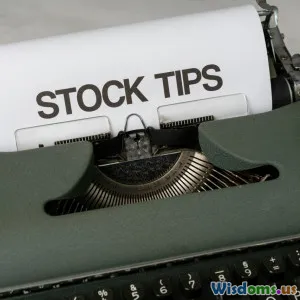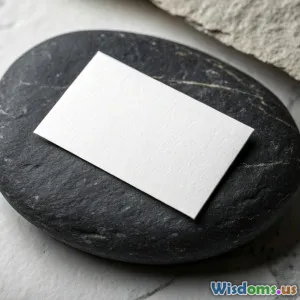
From Doodles to Dollars My Journey Selling Digital Art Online
9 min read Explore how a simple doodle led to a thriving online digital art business with practical tips and inspiring insights. (0 Reviews)
From Doodles to Dollars: My Journey Selling Digital Art Online
The realm of digital art has transformed from a niche hobby to a lucrative profession for many creatives around the world. But how did I go from casually sketching random doodles on a tablet to earning a sustainable income by selling digital art online? This article walks you through my journey, offering actionable insights, concrete examples, and practical strategies to help aspiring digital artists turn their creativity into a real business.
The Spark: From Casual Doodles to Serious Creation
Like many artists, my story began with simple, carefree doodles. It started purely out of passion—sketching characters, designing patterns, or creating quirky illustrations to share with friends on social media. But something shifted when I noticed people not only appreciating my art but also expressing interest in owning pieces digitally.
Why Digital Art?
Digital art offers unmatched flexibility and reach. Unlike traditional art confined to canvases and galleries, digital pieces can be distributed worldwide within seconds, thanks to platforms like Etsy, Redbubble, and even dedicated art marketplaces such as ArtStation.
Realization: Monetizing Creativity Requires More Than Talent
Talent is only part of the story. I quickly learned that understanding my audience, mastering the right tools, and establishing a system for promoting and selling my work online were crucial steps to make this a viable source of income.
Building Blocks of Selling Digital Art Online
Developing a Unique Style
Your art style is your signature. Early in my journey, I experimented with various techniques — from minimalistic line art to vibrant, textured digital paintings. The breakthrough came when I found a consistent theme combining whimsical characters with soft pastel palettes. This uniqueness attracted a niche audience looking for uplifting and cozy aesthetics.
Example: Artists like Loish and BossLogic owe much of their popularity to distinctive visual identities that set them apart in saturated marketplaces.
Mastering Digital Tools and Software
Investing time to learn professional-grade software such as Adobe Photoshop, Illustrator, and Procreate made a huge difference. Understanding how to efficiently use layers, brushes, and color profiles allowed me to increase productivity and produce high-quality art that met customer expectations.
According to a 2023 survey by the Digital Arts Collective, 72% of successful digital artists reported regular use of advanced tools like Procreate and Adobe Creative Cloud to diversify their offerings.
Choosing the Right Platforms
Early on, I tried selling through personal websites but quickly pivoted to marketplaces designed for digital artists. For instance:
- Etsy: Excellent for selling digital downloads like prints, cliparts, and design elements.
- Redbubble & Society6: Great for print-on-demand merchandise, letting artists focus on design without worrying about inventory or shipping.
- ArtStation: Targeted at professionals, perfect for portfolios and selling high-end digital assets like concept art.
Understanding the audience demographics and commission structures of each platform optimized my reach and profitability.
Pricing Strategy
Deciding how to price digital art can be tricky. I began by researching market rates and analyzing competitors in my niche. Then, I tested different price points for downloadable art versus print merchandise.
For example, digital prints downloadable at $10 attracted many impulse buyers, while limited edition digital illustrations sold for $50–$100 found value-conscious enthusiasts.
Marketing: Turning Viewers into Buyers
Social Media as a Launchpad
Instagram became my main promotional channel. Regular posting of progress shots, tutorials, and behind-the-scenes insights attracted followers and engaged my community.
Pro Tip: Using relevant hashtags like #digitalart, #doodleart, and #printondemand helped increase discoverability beyond my follower base. Collaborations with other artists and participating in monthly art challenges fueled constant growth.
Email Newsletters and Discounts
Building an email list enabled me to nurture leads, announce product drops, and offer exclusive discounts. Campaigns offering 10% off for first purchases boosted conversions considerably.
SEO and Listings Optimization
Every product listing was meticulously crafted with descriptive titles, keyword-rich descriptions, and clear preview images. For example, instead of “Summer Vibes Digital Art,” I used “Summer Palm Tree Digital Illustration Download for Wall Art.”
This attention to SEO helped my listings rank higher in both platform search engines and Google, attracting organic traffic without paid ads.
Overcoming Challenges: Real Talk from the Trenches
Freelancer Fatigue and Creative Blocks
Sustaining creativity isn’t always easy. I experienced phases of burnout and self-doubt. The solution? Establishing a consistent work schedule, taking short creative breaks (like analog doodling or exploring nature), and engaging with fellow artists in online communities.
Handling Copyright and Stolen Work
Digital art can be easily copied or misused. Implementing watermarks for online previews, registering copyrights, and addressing infringement through marketplace policies protected my work and business.
Scaling Up
As demand increased, I scaled by outsourcing administrative tasks and collaborating with print-on-demand services. This let me focus more on creative aspects while ensuring smooth order fulfillment.
Inspiring Stats and Success Stories
-
According to Grand View Research (2022), the global digital art market is expected to reach $9.5 billion by 2030, with increasing demand for NFTs and digital collectibles.
-
Independent artist bossLogic reportedly generated over $1 million annually by combining original digital content with strong community engagement.
-
Etsy’s reports show that digital art sales have surged year over year, highlighting growing consumer interest.
Conclusion: Your Path from Doodles to Digital Dollars
Selling digital art online is not just about having creative flair — it’s about blending artistry with entrepreneurship. My journey from casual doodler to professional digital artist taught me the value of a distinct style, mastering tools, choosing the right platforms, and engaging the audience strategically.
Whether you're a hobbyist looking to monetize your passion or an artist aiming for a full-time digital career, remember this: persistence, learning, and adapting make the difference.
Get started today by identifying your unique creative voice and exploring the platforms that align with your goals. The digital art marketplace is vast and full of opportunity — it’s time for your doodles to turn into dollars.
“Creativity takes courage.” — Henri Matisse
Make your courage count by transforming your art into a thriving online business.
Further Resources:
- Procreate Official Website
- Etsy Seller Handbook
- Digital Arts Collective Annual Survey
- ArtStation Learning
Images and graphics are recommended to complement this article if published on visual blog platforms or websites.
Rate the Post
User Reviews
Popular Posts





















